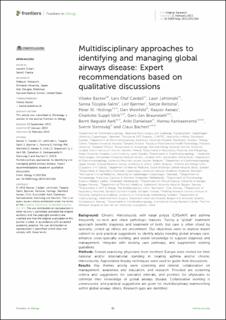| dc.contributor.author | Backer, Vibeke | |
| dc.contributor.author | Cardell, Lars Olaf | |
| dc.contributor.author | Lehtimäki, Lauri | |
| dc.contributor.author | Toppila-Salmi, Sanna K. | |
| dc.contributor.author | Bjermer, Leif | |
| dc.contributor.author | Reitsma, Sietze | |
| dc.contributor.author | Hellings, Peter Wim | |
| dc.contributor.author | Weinfeld, Dan | |
| dc.contributor.author | Aanæs, Kasper | |
| dc.contributor.author | Ulrik, Charlotte Suppli | |
| dc.contributor.author | Braunstahl, Gert-Jan | |
| dc.contributor.author | Aarli, Bernt Bøgvald | |
| dc.contributor.author | Danielsen, Arild | |
| dc.contributor.author | Kankaanranta, Hannu | |
| dc.contributor.author | Steinsvåg, Sverre Karmhus | |
| dc.contributor.author | Bachert, Claus | |
| dc.date.accessioned | 2023-04-03T13:31:57Z | |
| dc.date.available | 2023-04-03T13:31:57Z | |
| dc.date.created | 2023-02-22T21:05:23Z | |
| dc.date.issued | 2023 | |
| dc.identifier.issn | 2673-6101 | |
| dc.identifier.uri | https://hdl.handle.net/11250/3061875 | |
| dc.description.abstract | Background: Chronic rhinosinusitis with nasal polyps (CRSwNP) and asthma frequently co-exist and share pathologic features. Taking a “global” treatment approach benefits diagnosis and treatment of both, but care is often siloed by specialty: joined-up clinics are uncommon. Our objectives were to explore expert opinion to give practical suggestions to identify adults needing global airways care; enhance cross-specialty working; and widen knowledge to support diagnosis and management, integrate with existing care pathways, and supplement existing guidelines.
Methods: Sixteen practicing physicians from northern Europe were invited for their national and/or international standing in treating asthma and/or chronic rhinosinusitis. Appreciative Inquiry techniques were used to guide their discussions.
Results: Key themes arising were screening and referral, collaboration on management, awareness and education, and research. Provided are screening criteria and suggestions for specialist referrals, and pointers for physicians to optimize their knowledge of global airways disease. Collaborative working is underscored, and practical suggestions are given for multidisciplinary teamworking within global airways clinics. Research gaps are identified.
Conclusion: This initiative provides practical suggestions for optimizing the care of adults with CRSwNP and asthma. Discussion of the role of allergy and drug exacerbations on these conditions, and care for patients with other global airways diseases were beyond scope; however, we expect some principles of our discussion will likely benefit patients with related conditions. The suggestions bridge asthma and CRSwNP management guidelines, envisioning interdisciplinary, global airway clinics relevant to various clinical settings. They highlight the value of joint screening for early recognition and referral of patients. | en_US |
| dc.language.iso | eng | en_US |
| dc.publisher | Frontiers | en_US |
| dc.rights | Navngivelse 4.0 Internasjonal | * |
| dc.rights.uri | http://creativecommons.org/licenses/by/4.0/deed.no | * |
| dc.title | Multidisciplinary approaches to identifying and managing global airways disease: Expert recommendations based on qualitative discussions | en_US |
| dc.type | Journal article | en_US |
| dc.type | Peer reviewed | en_US |
| dc.description.version | publishedVersion | en_US |
| dc.rights.holder | Copyright 2023 The Author(s) | en_US |
| dc.source.articlenumber | 1052386 | en_US |
| cristin.ispublished | true | |
| cristin.fulltext | original | |
| cristin.qualitycode | 1 | |
| dc.identifier.doi | https://doi.org/10.3389/falgy.2023.1052386 | |
| dc.identifier.cristin | 2128410 | |
| dc.source.journal | Frontiers in Allergy | en_US |
| dc.identifier.citation | Frontiers in Allergy. 2023, 4, 1052386. | en_US |
| dc.source.volume | 4 | en_US |

